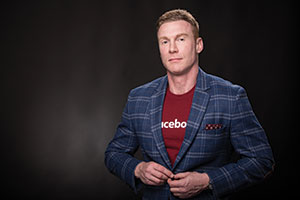Ross Sparkman’s résumé includes more than a decade of work in the United States Navy, a consulting gig with Deloitte and a short stint running people analytics for a unit of General Electric Co. But perhaps his most interesting job is the one he currently holds.
As head of strategic workforce planning for Facebook Inc., Sparkman has a front-row seat for arguably the most fascinating startup success story of recent times. Based in the social networking giant’s expansive open office in Menlo Park, California, Sparkman is responsible for leading workforce planning for a company skittish on thinking further than six months out. It’s a culture that contrasts starkly to Sparkman’s prior role with GE, where decision-making was strictly top-down and planning was a yearslong endeavor.
Talent Economy spoke with Sparkman more on the contrasting cultures, the rise of workforce planning and people analytics, and the inevitable workforce disruption from artificial intelligence. Edited excerpts follow.
TE: How has the field of workforce planning evolved over the past decade?
Sparkman: For starters, I think it’s become a little bit more mainstream now. I think typically when I talk to any type of HR practitioner, and even people outside of HR, they’re definitely familiar with what workforce planning is, but to some extent there’s still some confusion around it. I think in the past 10 years it’s definitely become a lot more data driven than it used to be. I think that it’s also more cross-functional now in terms of it being a part of finance, being a part of operations, being a part of HR.
TE: You’ve led workforce planning at GE Aviation and now at Facebook. How were those two jobs similar and how were they different?
 Sparkman: When you think about a company like GE, a 130-year-old company, you’re talking about a company that’s been through many transformations and deals with many types of industries. I think my observation in terms of the difference between the two companies is that a company like GE is in a much more steady state when it comes to planning; there’s not this hypergrowth that you would see with an organization like Facebook.
Sparkman: When you think about a company like GE, a 130-year-old company, you’re talking about a company that’s been through many transformations and deals with many types of industries. I think my observation in terms of the difference between the two companies is that a company like GE is in a much more steady state when it comes to planning; there’s not this hypergrowth that you would see with an organization like Facebook.
I think a lot of the processes are well embedded in the organization in terms of how planning is done. Not that there’s not still opportunity, but I think there’s more general accepted practices and definitions around what it is in a company like GE. I think it’s also a lot more of an eclectic workforce at a company like GE, because you know you have manufacturing and you have this sort of finance factor and high-tech now. So you have all different types of skills in a company like GE with different growth phases across the different businesses at GE, so I think there’s much more matrix sort of complexity at a company like GE, but I also think there’s more sort of maturity at a company like GE.
RELATED: Listen to the audio version of this interview as heard on Talent10x.
Facebook, on the other hand, is probably exactly the opposite. We are a very young company. We’ve only been around for 12 years. We’ve experienced a lot of the growing pains of moving from a startup to a midsized company. And so I think at Facebook we are much more inclined to make decisions that are quicker. I think that we are much more comfortable using data to make decisions and more comfortable with ambiguity and uncertainty, just in the internal and external environments.
‘When I did workforce planning at GE, I took A longer-term view of plans. At Facebook, six months is a long time to plan.’
TE: Do you have an example of how those differences change your approach to workforce planning?
Sparkman: When I did workforce planning at GE, I took a much longer-term view of the types of plans and how we would execute on them — so I’m looking three to five years out with a little more confidence than I would at Facebook. At Facebook, one of the first things that I was told is six months is a long time to plan. We’re just so dynamic. So my first shift was adjusting how I thought about timelines and planning. And I think to that end, I’ve been trying to mold Facebook a little bit in the sense that I think there’s still some opportunity to plan past six months to a year, and so we’re kind of coming to this situation where we’re kind of meeting in the middle. We’re not going to do these longer-term sort of plans, but we’re still going to do more than six months.
TE: How are the roles you might plan for different at the two companies?
Sparkman: A company like Facebook, Google or Pinterest, for example, we obviously are looking for extremely technical skills — we’re looking for machine learning, AI, software engineers, iOS software engineers, because these are the individuals at our company that drive our business models. But we’re not just looking for average sort of workers; we’re often looking for the crème de le crème. And the fact is that in this labor market right now they don’t necessarily exist, at least not here.
So there’s a really strong supply-demand issue that we’re facing, and the question becomes where do we get these individuals? Do we start to try to develop our own internally? Do we go overseas? Do we poach competitors? What’s the best way to meet the demand for the skill sets that we need? And obviously we have very ambitious plans. I mean, we’re trying to connect the whole world. To do that requires a certain level of skill and a shared number of people to help do it. The short answer is yeah, we’re definitely looking for a lot of technical type skills.
 GE is also going through a revolution in its business model. It’s moving toward a lot higher-skilled workforce also in certain areas. It’s still in traditional manufacturing, but I think it is positioning its business right now to move into the digital area. It actually is trying to compete to a certain extent with the Googles and the Facebooks of the world. Its challenge is its perceived brand is maybe not as sexy as maybe some of these companies in Silicon Valley. But make no mistake, there is definitely a part of their business model reliant on having these types of skills in the future. What you can see then is the trend in general is whether you’re a company like GE that’s been around for 130 years or a company like Facebook, both are converging on this sort of high-tech skill set.
GE is also going through a revolution in its business model. It’s moving toward a lot higher-skilled workforce also in certain areas. It’s still in traditional manufacturing, but I think it is positioning its business right now to move into the digital area. It actually is trying to compete to a certain extent with the Googles and the Facebooks of the world. Its challenge is its perceived brand is maybe not as sexy as maybe some of these companies in Silicon Valley. But make no mistake, there is definitely a part of their business model reliant on having these types of skills in the future. What you can see then is the trend in general is whether you’re a company like GE that’s been around for 130 years or a company like Facebook, both are converging on this sort of high-tech skill set.
TE: What lessons can CEOs of more mature businesses learn from a company like Facebook on workforce planning?
Sparkman: The biggest difference in terms of the impact that workforce planning has on a company like Facebook versus GE is that to my earlier point about the interaction with the C-suite. We’re not afraid to make decisions off of the data and we are a little bit more comfortable with uncertainty. And the reason we’re a little bit more comfortable with uncertainty is we’re willing to use the data — not just use it and analyze it, but make decisions off of it and make decisions off of it quickly.
A lot of these initiatives that you may see in the media sometimes around parental leave, anything that has to do with people, are all based off of analysis that we’ve conducted. We always put forth the data. We run the cost-benefit. We think through all the constraints. And we come up with a bunch of scenarios. Based on those scenarios we make a decision and we make a decision quickly, and we move to market with the decision. That’s really how we approach everything at Facebook. It’s kind of this fail fast approach, where we put the data forth, test it out and see what happens. If it doesn’t work out, then we adjust. It’s just that simple.
‘Machine learning algorithms are going to be so good that they’re going to be able to program themselves.’
I think GE is still pretty mature in how it approaches workforce planning, but other companies are not as comfortable with being able to use the data to make decisions because they haven’t done it in the past. It’s not part of their culture. So while they might be doing the planning, when the data suggests that they should take a certain action or go down a certain path, maybe they’re a little bit more hesitant than they should be. I think you have to make the commitment if you’re going to do it, make good decisions off of it, even when we only have data that helps reduce the uncertainty by 10 percent, that’s still beneficial than if you have 0 percent, which is just a guess.
The second thing that a lot of companies can take from us is the importance of having that executive support. You can’t just have one person that’s driving workforce planning and people analytics. You really have to make a commitment from the top to go after it and to become an organization that is going to always bring data to the table before making decisions. This doesn’t mean that you have to leave intuition at the front door. It just means if you’re going to make a decision, any type of decision with the people, to try to do any type of planning with people, much like if you were going to do some planning around to purchase a $5,000 piece of machinery. You’re going to go through and calculate net present value and the internal rate of return and return on assets from the purchase.
You’re going to do the same with people. You need to be able to make decisions and you need to have that support from the leaders on those decisions, and if you don’t, and you don’t have comfort with that, you’re just never going to have an effective workforce planning function or people analytics function in place. It’s going to be hard to gain steam.
 TE: If you were to advise a CEO on the greatest potential talent risk they need to pay more attention to, what would you tell them?
TE: If you were to advise a CEO on the greatest potential talent risk they need to pay more attention to, what would you tell them?
Sparkman: I think the biggest risks right now over the next 10 years or the most underestimated risks over the next 10 years is the impact that artificial intelligence and machine learning is going to have on automating the workforce. And let me elaborate on this. What I mean by this is that this is going to happen. The machines, the robots, are going to replace a lot more roles much faster than I think many people are aware. I do a lot of work with machine learning, and I’m well versed in understanding the potential benefits and risks that these types of advanced analytics can provide to an organization. And what’s going to happen is you’re going to have organizations that are going to be able to adapt their business models through repurposing their workforces that becomes redundant because of automated skills and are going to be able to realize cost savings that are going to be able to become a competitive advantage to their workforces.
I think they’re basically going to be able to develop a talent model that is flexible enough to leverage this machine learning and this AI. I think the companies that don’t see this coming right now, and who are not starting to think through this, especially the larger companies where there are a lot of manufacturing type roles and repetitive type skills sets — service industry call centers — these types of roles are really going to be quickly impacted. So the companies that don’t have a plan in place for this are going to find themselves at a disadvantage. From a CHRO perspective, then it becomes, Ok how do we deal with the workers that might find themselves out of a job? How does the contingent workforce and the contract workforce play into all of this? These are all variables and factors that could come into play in the next 10 years.
I think there are very few roles that aren’t going to be touched by these advances in technology. Even the software engineers writing code could potentially find themselves redundant because these machine learning algorithms are going to be so good that they don’t need the software engineers to even program them anymore — they’re going to be able to program themselves. So these are the types of things that pose a talent risk or opportunity, depending on how you think about it, for most organizations that they need to start thinking through.
Frank Kalman is Talent Economy’s Managing Editor.
Want more from Talent Economy, sign up here for newsletters, exclusives and more!















